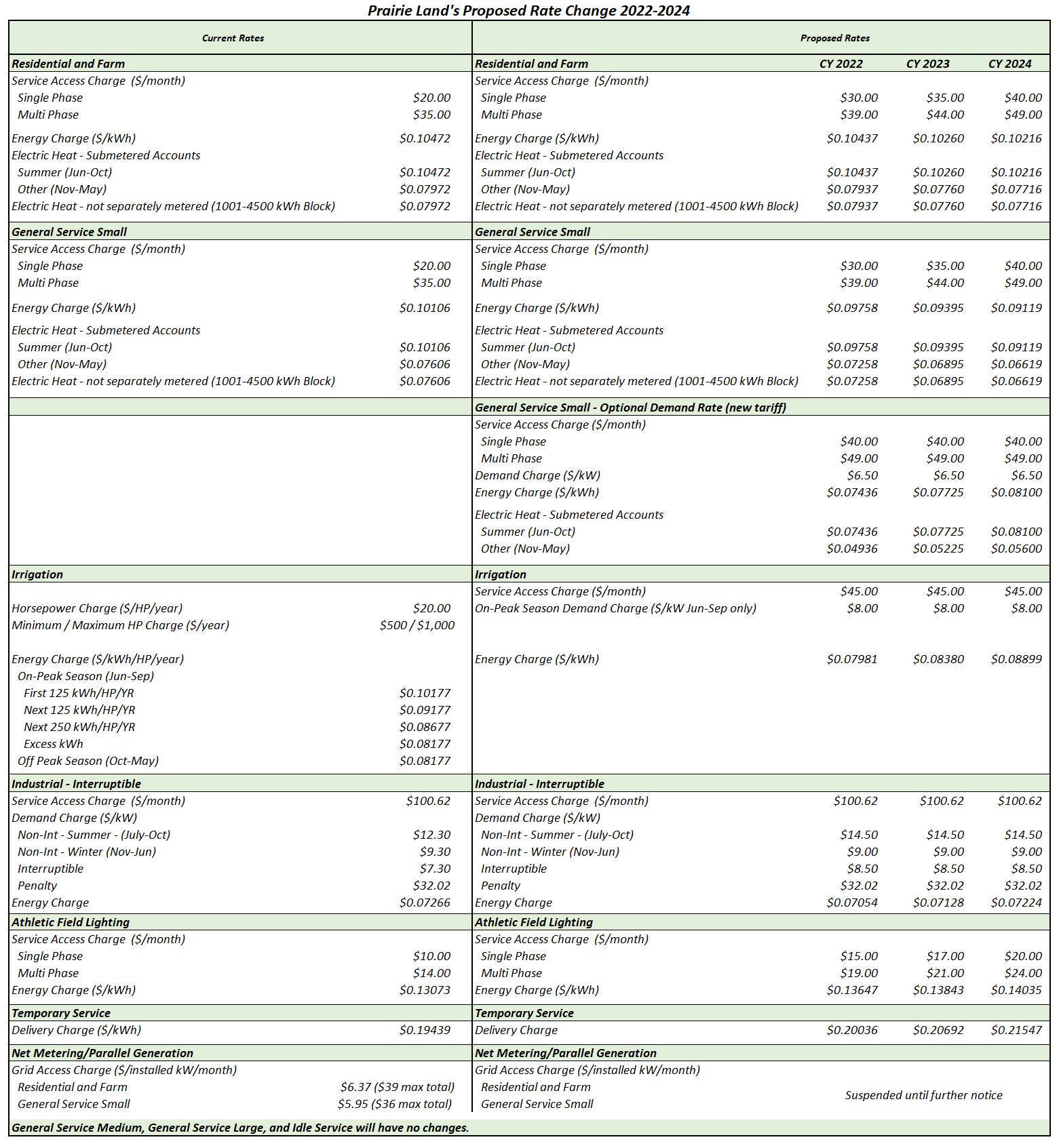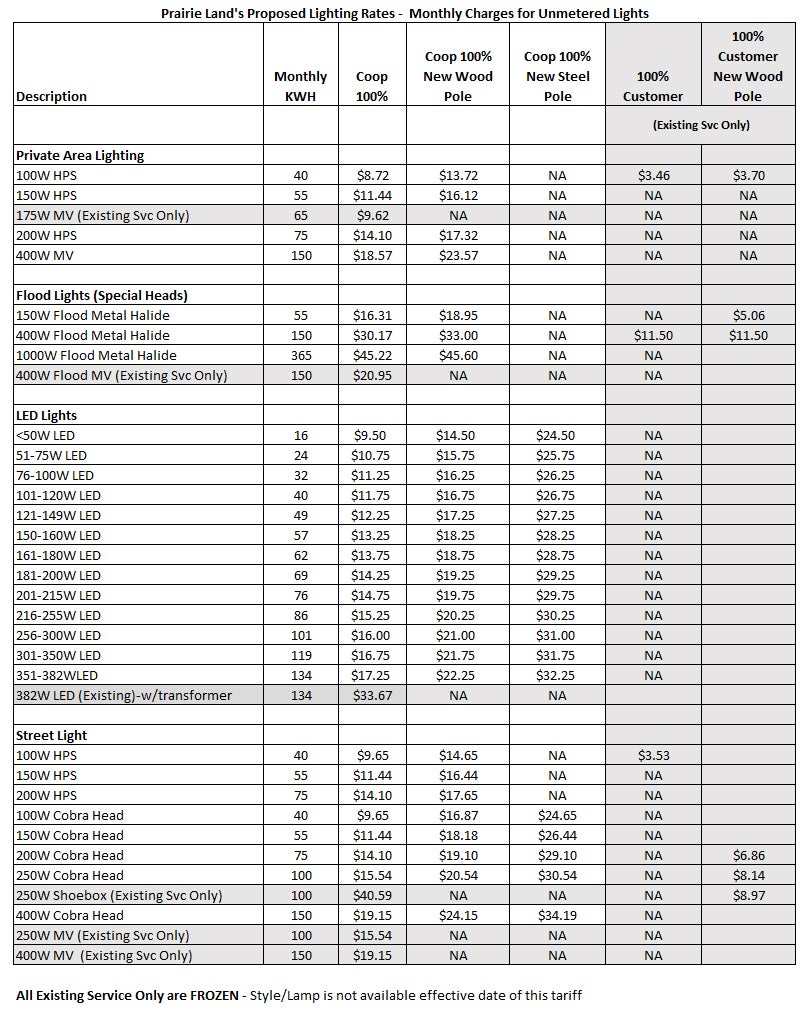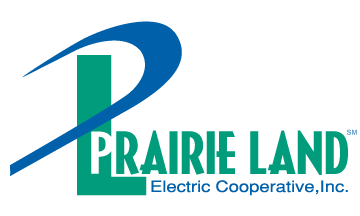In September 2021, we informed our members that Prairie Land was undergoing a rate study – a process that evaluates the Cooperative's costs of providing electric service and rates charged for this service. The purpose of this study was to (1) identify the overall revenue needed to cover Prairie Land’s operating expenses and debt obligations while generating enough capital to reinvest in our electrical system and (2) review the cost of providing service to each individual rate class (i.e., Residential, Commercial, Irrigation, etc.). This study, performed by an outside independent rate consultant, has now been completed. On Tuesday, November 23, 2021, at 1 PM, the Board of Trustees held a member rate meeting at the Norton office. Action on the retail rates were taken at that time. The meeting was open to any member who wished to attend and hear the rate proposal presentation.
The study showed that overall electric rate revenues should be increased by $5.6M, or about 8.3% percent, in 2022. After considering the magnitude of the potential financial impact to our members, Prairie Land’s board elected to lower the margins to the bare minimum but still adequate to meet loan covenants set by our lender. Additionally, we will gradually phase in the increase over three years (2022-2024) instead of fully adjusting rates at once in a single year.
After the adjustment to margin requirements, the required revenue increase for 2022 was reduced to $2.5M, or about 3.9%, with an additional $900K, or 1.3%, needed in 2023 and $1.2M, or 1.8%, in 2024. If approved by the board of trustees, the proposal will become effective on January 1, 2022. Previous base rate increase was implemented by Prairie Land in 2018. When compared to the ongoing monthly, if not daily, price escalations we are all experiencing when shopping for other products and services, your Cooperative’s infrequent rate change for such an essential commodity as electricity, underscores Prairie Land works hard to power your life reliably and affordably.
As you can see in the graph below, even after the proposed increase, Prairie Land's rates would remain among the lowest when compared to electric cooperatives in the state of Kansas.
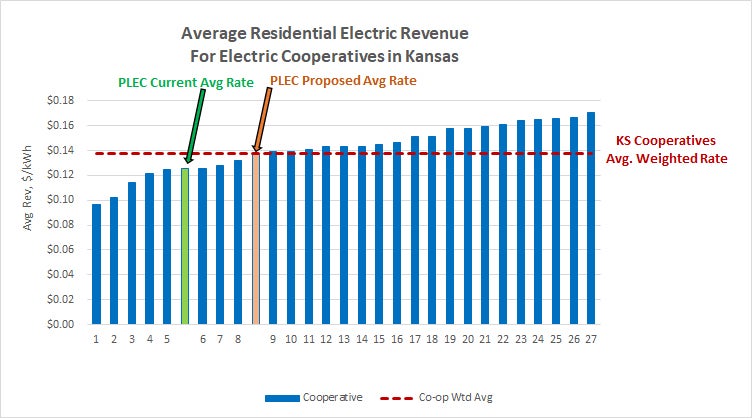
Rate design entails a balancing act between meeting our revenue needs and minimizing our members' financial impact. While the Cost of Service (COS) study indicates the need for a 3.9% increase in overall rate revenue, some rate classes will require more than the average, while others may need little or no increase. As a not-for-profit organization, we must recover our costs of doing business and maintain sufficient margins to reinvest in our electric distribution system. We all need a reliable energy grid, so we all share in the costs of building and maintaining it.
The amount of the rate change will vary by rate class. This is because the cost to provide service varies with each rate class depending on the size of the loads and the relative level of consumption. Some increases indicated by the COS were more significant, yet as proposed, the average increase to any affected customer class was capped at 9.8 percent.
One part of the proposal is to increase the monthly Service Access Charges to better align with the Cost of Service. This monthly flat charge that every member pays is designed to recover those costs that do not vary with the amount of electricity used. A portion of the Cooperative's costs are the same for customers within a rate class whether they use 50 kWh per month or 2,000 kWh per month. The Cooperative has made similar investments in poles, wires, transformers, and meters for most customers within the same rate class and incurs similar costs for reading meters, billing, and consumer accounting.
To demonstrate, let’s take a look at the residential service. The rate study has shown that the cost to connect a residential service to our electric distribution grid (i.e. cost incurred by the Cooperative just to have a service established even before a member uses a single kWh) is approximately $42/month. Currently, the Service Access Charge for a single-phase residential service is $20/month. Increasing the Service Access Charge to $30/month, as proposed, would lower the energy charges and more accurately reflect the cost of providing electric service to this rate class. The average residential customer would see a $9.68 per month increase on their bill. This is equivalent to only 32 cents/day. Another way to look at this is - paying $30 flat monthly fee translates into spending only $1/day for being able to receive an essential service such as electricity that powers every aspect of our daily lives.
The table below gives an overview of the proposed rate changes by rate class. The percentages shown reflect the monthly bill impact for the average usage customer within the class. However, the effect to each member within each rate class will vary depending on individual consumption.
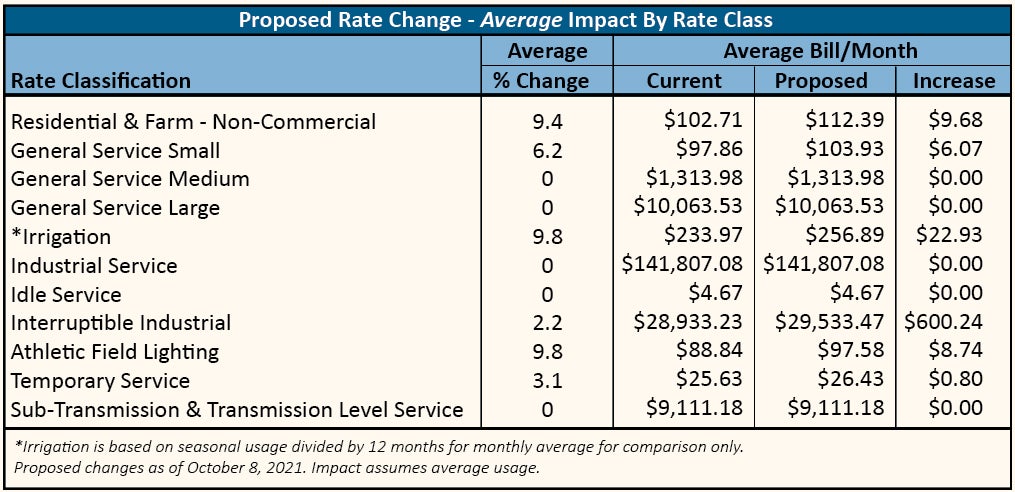
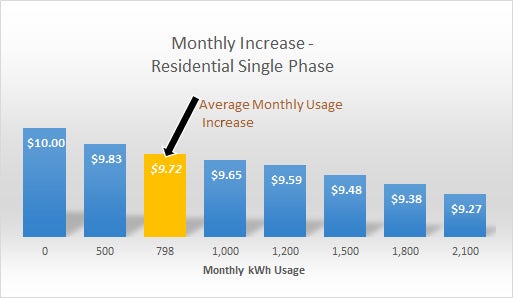
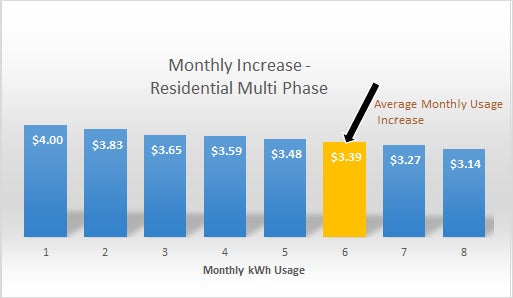
In addition to the schedules shown below, the Board will also review proposed changes for special contract rate, consider suspension of the Grid Access Charge for partial requirements service, and weigh in on miscellaneous recommended tariff language clarifications.
(Hint: click the images below to view a pdf version.)
In September 2021, we informed our members that Prairie Land was undergoing a rate study – a process that evaluates the Cooperative's costs of providing electric service and rates charged for this service. The purpose of this study was to (1) identify the overall revenue needed to cover Prairie Land’s operating expenses and debt obligations while generating enough capital to reinvest in our electrical system and (2) review the cost of providing service to each individual rate class (i.e., Residential, Commercial, Irrigation, etc.). This study, performed by an outside independent rate consultant, has now been completed. On Tuesday, November 23, 2021, at 1 PM, the Board of Trustees held a member rate meeting at the Norton office. Action on the retail rates were taken at that time. The meeting was open to any member who wished to attend and hear the rate proposal presentation.
Rate Study Results
The study showed that overall electric rate revenues should be increased by $5.6M, or about 8.3% percent, in 2022. After considering the magnitude of the potential financial impact to our members, Prairie Land’s board elected to lower the margins to the bare minimum but still adequate to meet loan covenants set by our lender. Additionally, we will gradually phase in the increase over three years (2022-2024) instead of fully adjusting rates at once in a single year.
After the adjustment to margin requirements, the required revenue increase for 2022 was reduced to $2.5M, or about 3.9%, with an additional $900K, or 1.3%, needed in 2023 and $1.2M, or 1.8%, in 2024. If approved by the board of trustees, the proposal will become effective on January 1, 2022. Previous base rate increase was implemented by Prairie Land in 2018. When compared to the ongoing monthly, if not daily, price escalations we are all experiencing when shopping for other products and services, your Cooperative’s infrequent rate change for such an essential commodity as electricity, underscores Prairie Land works hard to power your life reliably and affordably.
As you can see in the graph below, even after the proposed increase, Prairie Land's rates would remain among the lowest when compared to electric cooperatives in the state of Kansas.

Rate Change Summary
Rate design entails a balancing act between meeting our revenue needs and minimizing our members' financial impact. While the Cost of Service (COS) study indicates the need for a 3.9% increase in overall rate revenue, some rate classes will require more than the average, while others may need little or no increase. As a not-for-profit organization, we must recover our costs of doing business and maintain sufficient margins to reinvest in our electric distribution system. We all need a reliable energy grid, so we all share in the costs of building and maintaining it.
The amount of the rate change will vary by rate class. This is because the cost to provide service varies with each rate class depending on the size of the loads and the relative level of consumption. Some increases indicated by the COS were more significant, yet as proposed, the average increase to any affected customer class was capped at 9.8 percent.
Change in Service Access Charge
One part of the proposal is to increase the monthly Service Access Charges to better align with the Cost of Service. This monthly flat charge that every member pays is designed to recover those costs that do not vary with the amount of electricity used. A portion of the Cooperative's costs are the same for customers within a rate class whether they use 50 kWh per month or 2,000 kWh per month. The Cooperative has made similar investments in poles, wires, transformers, and meters for most customers within the same rate class and incurs similar costs for reading meters, billing, and consumer accounting.
To demonstrate, let’s take a look at the residential service. The rate study has shown that the cost to connect a residential service to our electric distribution grid (i.e. cost incurred by the Cooperative just to have a service established even before a member uses a single kWh) is approximately $42/month. Currently, the Service Access Charge for a single-phase residential service is $20/month. Increasing the Service Access Charge to $30/month, as proposed, would lower the energy charges and more accurately reflect the cost of providing electric service to this rate class. The average residential customer would see a $9.68 per month increase on their bill. This is equivalent to only 32 cents/day. Another way to look at this is - paying $30 flat monthly fee translates into spending only $1/day for being able to receive an essential service such as electricity that powers every aspect of our daily lives.
Monthly Bill Impact Overview
The table below gives an overview of the proposed rate changes by rate class. The percentages shown reflect the monthly bill impact for the average usage customer within the class. However, the effect to each member within each rate class will vary depending on individual consumption.



Proposed Rate Tariffs
In addition to the schedules shown below, the Board will also review proposed changes for special contract rate, consider suspension of the Grid Access Charge for partial requirements service, and weigh in on miscellaneous recommended tariff language clarifications.
(Hint: click the images below to view a pdf version.)
